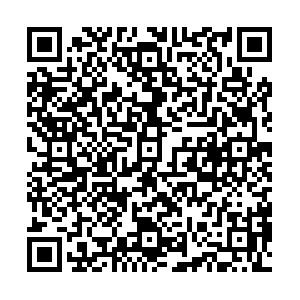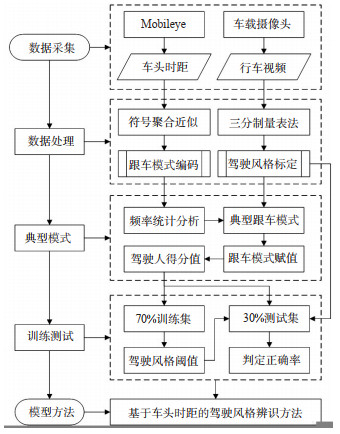Classification of Driving Style Using Simplified Features of Headway Under the Connected Vehicles Environment
-
摘要:
基于现有网联数据获取技术与条件,从车联网系统提取车头时距参数并将3 s内的车头时距特征值定义为驾驶模式,根据驾驶模式进而对驾驶风格(即驾驶人的驾驶行为习惯)进行分类。通过车头时距特性对驾驶模式进行量化分类,根据标定好的驾驶风格结果,辨识每种驾驶风格包含的典型驾驶模式;运用模糊分类方法赋予典型驾驶模式相应分值,通过计算每位驾驶人分值并结合已标定的驾驶风格结果设定每种驾驶风格的阈值;利用该阈值对测试集中的驾驶人风格进行识别,以验证识别准确率。采集了44名驾驶人网联环境行车数据将驾驶人标定为激进型、普通(即既不保守也不激进)型和保守型。按上述方法设置各驾驶风格阈值,结果表明:各驾驶风格的阈值分别为:S < 64.67为保守型,64.67 ≤ S < 181.20为普通型,S ≥ 181.20为激进型;使用所提方法来识别驾驶人风格,总体准确率为85.7%。所提出的基于车头时距的驾驶风格分类方法,使用了极精简的驾驶行为参数,为驾驶风格分类应用提供了新思路。
Abstract:Based on current data collection techniques from connected vehicles, this paper aims to classify driving styles(i.e., driving habits or behavior)by analyzing driving modes which is defined as time headway in 3 s. Specifically, driving modes are quantitatively classified by time headway and typical driving modes reflecting each driving style are identified according to the calibrated driving styles. Evaluation score is assigned to each typical driving mode using a fuzzy classification method and the thresholds of each driving style is proposed based on the evaluation scores and the calibrated driving styles. The thresholds are applied to a test data set, which includes driving behavior data of 44 drivers, to verify the accuracy of the proposed method. In summary, three types of driving styles are identified: the evaluation score S < 64.67 is seen as the conservative driving style(CDS), the score 64.67 ≤ S < 181.20 is classified as the"regular"(that is, neither-conservation-nor-aggressive(NCNA))driving style; and the score S ≥ 181.20 is grouped into the aggressive driving style(ADS). Study results show that the accuracy of the proposed method against the testing data set is 85.7%. The proposed method uses simplified driving parameters (headway)for driving-style classification, which provides a new way for driving-style classification.
-
表 1 车头时距等级划分情况
Table 1. Classification of THW class
车头时距/s > 0~0.6 > 0.6~1.0 > 1.0~1.5 > 1.5~2.0 > 2.0~2.5 > 2.5~4.0 > 4.0~6.0 > 6.0~∞ 等级 1 2 3 4 5 6 7 8 表 2 自然驾驶平台采集的原始数据
Table 2. Raw data from a natural flight platform
数据来源 变量名 油门踏板开度/% 制动压力/MPa 车载CAN总线 转向盘角度/(°) 转向盘角速度/((°)/s) 本车车速/(km/h) 本车横向加速度/(m/s2) 本车纵向加速度(m/s2) 惯导系统 横摆角速度(Os) 经度/(°) 纬度/(°) 距右车道线距离/m 距左车道线距离/m Mobileye 同车道前车车头间距(DHW)/m 同车道前车车头时距(THW)/s 同车道前车碰撞时间(TTC) /s 表 3 驾驶风格标定结果
Table 3. The result of driving style calibration
驾驶风格 激进型 普通型 保守型 人数 6 22 16 表 4 典型驾驶模式初始分值
Table 4. Typical initial values of the following patterns
驾驶风格 激进型 普通型 保守型 初始分值 15 5 -5 表 5 部分典型的驾驶模式隶属度及对应分值
Table 5. A part of the membership and the corresponding values of typical car following patterns
激进型 普通型 保守型 驾驶模式 隶属度 分值 驾驶模式 隶属度 分值 驾驶模式 隶属度 分值 222 1.000 0 15.00 333 1.000 0 5.00 666 1.000 0 -5.00 433 0.103 5 1.56 444 0.823 3 4.12 777 0.390 8 -1.95 332 0.100 9 1.52 544 0.085 3 0.43 555 0.380 5 -1.90 443 0.094 0 1.41 554 0.073 3 0.37 665 0.050 6 -0.25 322 0.090 7 1.36 654 0 0 566 0.043 5 -0.22 表 6 训练集驾驶人得分情况
Table 6. Training set the driver of the score
分值 驾驶人风格类型 激进型 普通型 保守型 平均分值 399.03 123.11 -15.03 分值标准差 96.63 85.02 135.38 分值极大值 436.99 238.38 222.81 分值极小值 273.94 -180.03 -81.21 表 7 测试集驾驶人得分情况
Table 7. Drivers'scoring of test set
序号 专家1评分 专家2评分 专家3评分 三分制评价结果 模型分值 识别结果 1 1 2 2 2 -13.67 1 2 1 1 1 1 -13.74 1 3 2 3 3 3 309.83 3 4 2 1 2 2 41.14 1 5 1 2 2 2 86.68 2 6 1 1 1 1 64.09 1 7 2 2 2 2 66.00 2 8 2 2 2 2 75.84 2 9 2 1 1 1 -25.02 1 10 2 3 2 2 82.89 2 11 2 1 1 1 27.98 1 12 1 2 2 2 133.89 2 13 2 1 1 1 -27.56 1 14 2 3 3 3 244.58 3 注:1-保守型;2-普通型;3-激进型。 -
[1] FRENCH D J, WEST R J, Elander J, et al. Decision-making style, driving style, and self-reported involvement in road traffic accidents[J]. Ergonomics, 1993(36): 627-644. http://www.researchgate.net/profile/John_Wilding/publication/14685091_Decision-making_style_driving_style_and_self-reported_involvement_in_road_traffic_accidents/links/0912f50b9260ae158c000000.pdf [2] SAGBERG F, SELPI S, PICCININI G F B, et al. A Review of research on driving styles and road safety[J]. Human Factors: The Journal of the Human Factors Society, 2015, 57(7): 1248-1275. doi: 10.1177/0018720815591313 [3] 万豫, 黄妙华, 王思楚. 基于改进DBSCAN算法的驾驶风格识别方法研究[J]. 合肥工业大学学报(自然科学版), 2020, 43(10): 23-30. https://www.cnki.com.cn/Article/CJFDTOTAL-HEFE202010003.htmWAN Y, HUANG M H, WANG S C. Study on driving style recognition based on improved DBSCAN algorithm[J]. Journal of Hefei University of Technology(Natural Science), 2020, 43(10): 23-30. (in Chinese) https://www.cnki.com.cn/Article/CJFDTOTAL-HEFE202010003.htm [4] DENG C, WU C Z, LYU N C, et al. Driving style recognition method using braking characteristics based on hidden Markov model[J]. Plos One, 2017, 12(8): 0182419. http://journals.plos.org/plosone/article/file?id=10.1371/journal.pone.0182419&type=printable [5] 余荣杰, 龙晓捷, 涂颖菲, 等. 基于低频轨迹数据的分时租赁驾驶人驾驶风格分析[J]. 同济大学学报(自然科学版), 2019, 47(10): 1463-1469. doi: 10.11908/j.issn.0253-374x.2019.10.011YU R J, LONG X J, TU Y F, et al. Driving style analysis of time-sharing rental drivers based on low frequency trajectory data[J]. Journal of Tongji University(Natural Science), 2019, 47(10): 1463-1469. (in Chinese) doi: 10.11908/j.issn.0253-374x.2019.10.011 [6] AMIN M, RAMIN A, ASAD J K. Classifying travelers'driving style using basic safety messages generated by connected vehicles: Application of unsupervised machine learning[J]. Transportation Research Part C: Emerging Technologies, 2021(122): 102917. http://www.sciencedirect.com/science/article/pii/S0968090X20308160 [7] ALJAAFREH A, ALSHABATAT N, AL-DIN M. Driving style recognition using fuzzy logic[C]. 2012 IEEE International Conference on Vehicular Electronics and Safety (ICVES 2012), Istanbul, Turkey: IEEE, 2012. [8] CARSTEN O, KIRCHER K, JAMSON S. Vehicle-based studies of driving in the real world: The hard truth?[J]. Accident Analysis & Prevention, 2013, 58(5): 162-174. http://pdfs.semanticscholar.org/0808/72a6480f631994522fc71c01d0eb33ff639f.pdf [9] 邓天民, 朱杰, 朱凯家. 基于iForest+Biscting K-means的驾驶风格分类识别方法研究[J]. 重庆交通大学学报(自然科学版), 2021, 40(6): 1-6. doi: 10.3969/j.issn.1674-0696.2021.06.01DENG T M, ZHU J, ZHU K J, et al. Study on classification and recognition of driving style based on iForest + Biscting K-means[J]. Journal of Chongqing Jiaotong University(Natural Science)2021, 40(6): 1-6. (in Chinese) doi: 10.3969/j.issn.1674-0696.2021.06.01 [10] PADILLA J L, CASTRO C, DONCEL P, et al. Adaptation of the multidimensional driving styles inventory for Spanish drivers: Convergent and predictive validity evidence for detecting safe and unsafe driving styles[J]. Accident Analysis & Prevention, 2020(136): 1045413. http://www.sciencedirect.com/science/article/pii/S0001457519300752 [11] 张雪榆, 潘存书, 徐进. 城市道路多车道交织区的微观驾驶行为特性[J]. 交通信息与安全, 2020, 38(3): 138-147. doi: 10.3963/j.jssn.1674-4861.2020.03.018ZHANG X Y, PAN C S, XU J. Micro-interleaved multi-lane area of urban road driving behaviors[J]. Traffic Information and security, 2020, 38(3): 138-147.(in Chinese) doi: 10.3963/j.jssn.1674-4861.2020.03.018 [12] TAUBMAN-BEN-ARI O, MIKULINCER M, GILLATH O. The multidimensional driving style inventory-scale construct and validation[J]. Accident Analysis & Prevention, 2004, 36 (3): 323-332. http://www.researchgate.net/profile/Mario_Mikulincer/publication/7487488_The_multidimensional_driving_style_inventory_-_Scale_construct_and_validation/links/573d6ffb08ae298602e5a523.pdf [13] 孙龙, 杨程程, 常若松. 多维度驾驶风格量表的修订及初步应用[J]. 人类工效学, 2014, 20(2): 6-9. https://www.cnki.com.cn/Article/CJFDTOTAL-XIAO201402003.htmSUN L, YANG C C, CHANG R S. Revision and preliminary application of multidimensional driving style scale[J]. Ergonomics, 2014, 20(2): 6-9. (in Chinese) https://www.cnki.com.cn/Article/CJFDTOTAL-XIAO201402003.htm [14] LI G F, LI S E, CHENG B, et al. Estimation of driving style in naturalistic highway traffic using maneuver transition probabilities[J]. Transportation Research Part C: Emerging Technologies, 2017(74): 113-125. http://smartsearch.nstl.gov.cn/paper_detail.html?id=b8c1be8ae08c94cdf69a08976cab645e [15] MARIA V N Z, MENG F L, SU J Y, et al. Dynamic clustering analysis for driving styles identification[J]. Engineering Applications of Artificial Intelligence, 2021(97): 104096. http://www.sciencedirect.com/science/article/pii/S0952197620303468 [16] 王畅, 付锐, 彭金柱, 等. 应用于换道预警的驾驶风格分类方法[J]. 交通运输系统工程与信息, 2014, 14(3): 187-193. doi: 10.3969/j.issn.1009-6744.2014.03.029WANG C, FU R, PENG J Z, et al. Driving style classification method applied to lane change warning[J]. Systems Engineering, 2014, 14(3): 187-193. (in Chinese) doi: 10.3969/j.issn.1009-6744.2014.03.029 [17] GUO Q Y, ZHAO Z G, SHEN P H, et al. Adaptive optimal control based on driving style recognition for plugin hybrid electric vehicle[J]. Energy, 2019(186): 115824. http://econpapers.repec.org/article/eeeenergy/v_3a186_3ay_3a2019_3ai_3ac_3as0360544219314963.htm [18] 刘通, 付锐, 张名芳, 等. 融合K-means与高斯混合模型的驾驶风格聚类研究[J]. 中国安全科学学报, 2019, 29 (12): 40-45. https://www.cnki.com.cn/Article/CJFDTOTAL-ZAQK201912007.htmLIU T, FU R, ZHANG M F, et al. Driving style clustering based on hybrid model of K-means and Gauss[J]. Chinese Journal of Security Sciences, 2019, 29(12): 40-45. (in Chinese) https://www.cnki.com.cn/Article/CJFDTOTAL-ZAQK201912007.htm [19] 王鑫鹏, 陈志军, 吴超仲, 等. 考虑驾驶风格的智能车自主驾驶决策方法[J]. 交通信息与安全, 2020, 38(2): 37-46. doi: 10.3963/j.jssn.1674-4861.2020.02.005WANG X P, CHEN Z J, WU C Z, et al. Consider intelligent autonomous decision method of driving the car driving style[J]. Journal of Transport Information and safety, 2020, 38(2): 37-46. (in Chinese) doi: 10.3963/j.jssn.1674-4861.2020.02.005 [20] 李明俊, 张正豪, 宋晓琳, 等. 基于一种多分类半监督学习算法的驾驶风格分类模型[J]. 湖南大学学报(自然科学版), 2020, 47(4): 10-15. https://www.cnki.com.cn/Article/CJFDTOTAL-HNDX202004002.htmLI M J, ZHANG Z H, SONG X L, et al. Driving style classification model based on a multi-classification semi-supervised learning algorithm[J]. Journal of the Hunan University (Natural Science), 2020, 47(4): 10-15. (in Chinese) https://www.cnki.com.cn/Article/CJFDTOTAL-HNDX202004002.htm [21] MACADAM C, BAREKET Z, FANCHER P, et al. Using neural networks to identify driving style and headway control behavior of drivers[J]. Vehicle System Dynamics, 1998, 29(1): 143-160. http://www.researchgate.net/profile/Zevi_Bareket/publication/245309079_USING_NEURAL_NETWORKS_TO_IDENTIFY_DRIVING_STYLE_AND_HEADWAY_CONTROL_BEHAVIOR_OF_DRIVERS/links/54bd5d5f0cf27c8f2814b6b9.pdf [22] MARTINEZ C M, HEUCKE M, WANG F Y, et al. Driving style recognition for intelligent vehicle control and advanced driver assistance: A survey[J]. IEEE Transactions on Intelligent Transportation Systems, 2018, 19(3): 666-676. doi: 10.1109/TITS.2017.2706978 [23] LIN J, KEOGH E J, LONARDI S, et al. A Symbolic Representation of Time Series, with Implications for Streaming Algorithms[C]. 8th ACM SIGMOD Workshop on Research Issues in Data Mining and Knowledge Discovery, San Diego, California: USA, 2003. [24] LYU N C, DENG C, XIE L, et al. A field operational test in China: Exploring the effect of an advanced driver assistance system on driving performance and braking behavior[J]. Transportation Research Part F: Traffic Psychology and Behaviour, 2019(65): 730-747. http://www.sciencedirect.com/science?_ob=ShoppingCartURL&_method=add&_eid=1-s2.0-S1369847816306672&originContentFamily=serial&_origin=article&_ts=1520521217&md5=205f499431f7c021df09c13c97e32c06 [25] CHEN C, ZHAO X, ZHANG Y L, et al. A graphical modeling method for individual driving behavior and its application in driving safety analysis using GPS data[J]. Transportation Research Part F: Traffic Psychology and Behaviour, 2019(63): 118-134. http://www.onacademic.com/detail/journal_1000042281617099_d096.html [26] CHOW S. Sample size calculations in clinical research[M]. London: Taylor & Francis, 2007. [27] 刘通, 付锐, 马勇, 等. 考虑驾驶人风格的跟车预警规则研究[J]. 中国公路学报, 2020, 33(2): 170-180. https://www.cnki.com.cn/Article/CJFDTOTAL-ZGGL202002016.htmLIU T, FU R, MA Y, et al. Interleaved multi-lane urban roads into account research on driving style come with alert rules[J]. China Journal of Highway and Transport, 2020, 33 (2): 170-180. (in Chinese) https://www.cnki.com.cn/Article/CJFDTOTAL-ZGGL202002016.htm -





 下载:
下载:








